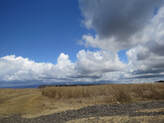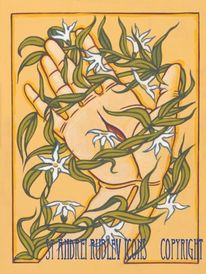 “I reach out my hand.” The past few weeks this phrase keeps repeating itself in my mind, inspired by the people where I live. It is incredibly moving and deeply humbling to see how people who have suffered so much loss continue to reach out to one another. In the past few weeks there have been many natural disasters which have been overwhelming in magnitude to both individuals and entire communities. In all the destruction and in all the loss there is much to reflect upon, even with awe and amazement. I say this because again and again I have witnessed the hands of people reaching out to one another, regardless of whether they personally lost their homes and possessions or not. As one person pointed out, no one is asking the ethnicity, creed, country of origin, age, gender identity, religion, or socio-economic situation of the other. Instead, people are holding out their hands to one another both to give and to receive. It is nothing short of what Jesus taught in the gospels which is to love your neighbor as yourself. Giving means to offer what one has, whether it is monetary, material, spiritual, or simply the solidarity of friendship. No gift is too small and no act of love is without great impact. To reach out to one another is to offer the love which Jesus taught us to share, and it is in reaching out our hand to the other that we also find Him. There are many who will remain unrecognized either as heroes or simply as caring individuals, but we can find inspiration in the lives of many recognized saints, too. St. (Padre) Pio of Pietrelcina, whose feast day is September 23, is one such person. He was born Francesco Forgione on May 25, 1887 in a tiny town in Italy and entered the Franciscans at the age of 15, taking the religious name Pio. He was ordained at 23 after a rather rough period which involved prolonged illness and many sufferings. Padre Pio suffered physically his entire life: he had continual stomach trouble which defied diagnosis and therefore was difficult to treat. However, suffering seemed to be the fertile ground from which sprang the many spiritual gifts he was given by God, and particular among his sufferings was the stigmata, (the five wounds of Christ) which he willingly bore. It seems he felt called to offer himself for others. Not long after his ordination he wrote a letter to his spiritual director, Father Benedetto Nardella, in which he asked permission to offer his life as a victim for sinners.* Padre Pio also suffered from harassment by the devil with whom he literally fought for many years, often during the night.  While his suffering may seem almost unbelievable, Padre Pio accepted all of it as a way of prayer for others, something referred to as redemptive suffering. Let us be clear: suffering is a mystery. God does not send suffering to torment or punish us, and it is something no one can escape, not even Jesus. Therefore, it has no correlation to our goodness or lack thereof. It has value, or God would not have chosen it as the path for Jesus to redeem us. Although suffering often appears to be senseless, and can feel too painful to bear, it can be a way we come to learn deeper compassion and love. It causes us to reach out to one another not only for help, but to see past the externals into the very heart of the other, and teaches us to expand our hearts to both give and receive in ways we would never have thought possible. When we fall to our knees we are given an invitation to place our own bruised and battered hand into the wounded hand of Jesus offered through the outstretched hand of the one who is reaching out to comfort us. Padre Pio did not embrace suffering because he was some sort of masochist, but rather he recognized the suffering in other people and entered into it so that he could offer them the healing power of Jesus: he intimately knew of their intense physical pain and agonizing emotional suffering, but he did not stop there. We, too, can enter into the healing power of Christ by simply reaching out with some small act of love. **  Padre Pio comes to mind presently because he never stopped reaching out to others, and in so doing he teaches us the core message of the gospel, which is to love. Jesus said we are to love our neighbor, clearly indicating that our neighbor is every man and woman regardless of where they come from or who they might be. Every person is a loved sinner, beautiful in God’s eyes, and therefore all have equal dignity. This does not mean that God condones every action of every person, nor does it mean that we should overlook sin and evil, (in fact, we have an obligation to correct those who sin), but what it does mean is that basically we are to love the sinner, even while hating the sin. In other words, God does judge and He does punish the unrepentant, but He is also full of boundless mercy. We are to leave the judging to God because, as in the old adage, “there but for the grace of God, go I.” However, we are to imitate His mercy. This is not easy by any means, but we are called to live this way with the help of God’s grace. In the New Testament the word agapè is used to describe this kind of love. It basically means the love with which God loves us; unconditional love; loving those who are hardest to love. It is the love which forgives transgressions against us and which reaches out its hand to whoever it can. 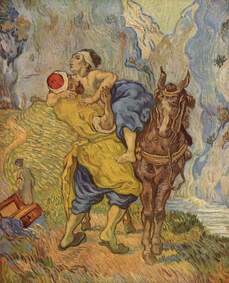 It is also important to note that throughout the Gospels Jesus was clear that love of God is connected to love of neighbor. When asked to identify the greatest commandment He said to love God with all our heart and soul; but without hesitation He added that we are to love our neighbor as ourselves. (Mark 12:31) Jesus continued this connection when He taught that in giving to our brothers and sisters we are giving to Him, and conversely, whatever we deny our brothers or sisters we are denying Him. In the Gospels we also see that Jesus is emphatic about our need for generosity: it is this form of love on which we will be judged. (See Matthew 25:31-46; also see Luke 16:19-31) Finally, in John's Gospel Jesus said, “I give you a new commandment; love one another. As I have loved you, so you also should love one another.” (John 13:34) We are to love others the way we are loved by Him! If this feels overwhelming, there is good news here. We do not do this by ourselves, but rather, if we ask for our hearts to be opened, Jesus will give us what it takes to stretch so that we might be able to love in the way of agapè. 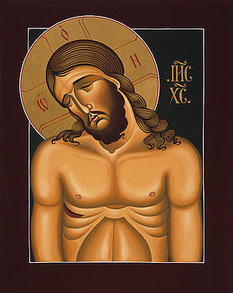 To love is to be compassionate. The evangelist Matthew used the Hebrew word rachamim in reference to a reaction by Jesus when He was asked to heal someone. In English it is translated to compassion, but rachamim actually means ‘a movement in the womb of God,’ a profoundly intimate experience. The compassion which Jesus has for us, then, is incredibly intimate because He has eternally entered into our woundedness by allowing Himself to suffer and die for us. Our compassion is given life through His insofar as it is an intimate movement deep within our hearts which joins us to the pain of another. Compassion is not merely to identify with the other, it is to fully enter into the pain or sorrow with them. So while someone may not have actually suffered loss in a particular situation they can still reach out and grasp the hand of the other, entering into whatever it is with them. They cannot change the circumstances, but they can be there with the one who suffers, easing their pain by offering themselves and their giftedness. 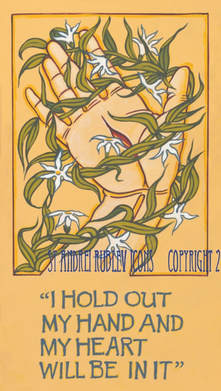 In this time of suffering and loss for many, it is good to remember that compassion involves reaching out in whatever way we can. It also means being a good receiver. That is, our gratitude is shown in accepting help, even if we are generally quite self-sufficient and would rather give than receive. No one enjoys needing so much help, but part of being a disciple is having the humility and gratitude to receive the outstretched hand of the other. By accepting we are giving them the gift of being able to serve. Let us learn from Padre Pio, who in turn learned from Jesus that the best way to ease suffering is to reach out to our brothers and sisters with compassion, holding out our hands so that we actually touch, and in doing so, letting heart speak to heart. May we ask for the graces we need to persevere through whatever our present suffering might be! May we have the courage to reach out, offering whatever humble gift we can! May we be inspired by saints such as Padre Pio who encourage us to find Christ in one another and to embrace His presence in love! May we find strength in our own outstretched hands joined to those of others! May we continue to pray for all the victims of natural disasters and also for those who are able to respond with aid! And may we love as Jesus taught us, remembering that even the smallest act of love is huge for the one who receives it! Let us continue to meet in the heart of Jesus! Peace! ©Michele L. Catanese * http://padrepiodevotions.org/a-short-biography/ ** https://aleteia.org/2017/01/31/st-padre-pio-bore-the-stigmata-but-one-secret-wound-was-more-painful-than-the-others/?utm_campaign=english_page&utm_medium=aleteia_en&utm_source=Facebook#link_time=1505853548 Note: Next post will be October 9. Images: 1. This is part of an image by Fr. William Hart McNichols called I Hold Out My Hand and My Heart Will Be In It. See the last note for complete information. 2. This icon is also the work of Fr. William Hart McNichols; it is called Saint Padre Pio Mother Pelican. I chose it because as Fr. Bill depicted him, Padre Pio was like the mother pelican who pierces its own breast in order to feed its young when no food can be found. Pelicans are ungainly birds. They look a bit awkward when they are on the ground, but when they fly they are of the most graceful birds to grace the air. If they find no food, they will use their own blood to feed their young. Padre Pio did just that. He ‘fed’ his spiritual children from the font of the blood he shed in imitation of Jesus; he fed them with the gifts he was given and with the sacraments he celebrated so reverently. If you would like to purchase a copy of this icon, it can be found at https://fineartamerica.com/featured/2-st-padre-pio-mother-pelican-047-william-hart-mcnichols.html. 3. This is one of my photos, taken in Palo Duro Canyon, Texas. I chose to place it here because the climber's efforts reminded me of how insurmountable suffering can feel at certain times in our lives. She almost seems to be at a loss as to whether to go up or down, but she is held in place by a tether and harness. This image reminds me that we are tethered to Christ in love and that we cannot go it alone. We need help. 4. This is another of my photos, taken at a roadside waterfall and stream in Rocky Mountain National Park, in Estes Park, Colorado. I chose to use it because this image speaks in two ways. First our suffering and the events in our lives can seem like this eddy: we feel the rush of the water and think we might drown. However, the water which is also rushing over us is the water of God's love which is life-giving. It is the mercy and grace given us by God. 5. This is a painting by Vincent van Gogh which is quickly becoming one of my favorites from among his work. It is The Good Samaritan from the parable taught by Jesus in the Gospel of Luke. (Luke 10:29-36) Some details to note are the suffering etched in the face of the victim, and also that the two figures who did not stop and render aid are depicted as undersized, perhaps symbolic of their small-heartedness. But there is also great tenderness shown on the face of the Samaritan, and even the horse seems to have a look of understanding and gentleness. I chose this because it seems to me that the Parable of The Good Samaritan epitomizes the generosity to which we are called. 6. This is another icon from the work of Fr. William Hart McNichols. It is called Jesus Christ Extreme Humility. I chose to use it here because it shows what Jesus underwent in his suffering and death which was the ultimate in humility: the Son of God became a man and then died a horrible, unjustified death, totally rejected. Yet He is Compassion and He is Love. While being fully God, He entered into our humanity fully to give us redemption, hope, and ultimately the ability to enter into His glory. You can find this icon at https://fineartamerica.com/featured/jesus-christ-extreme-humility-036-william-hart-mcnichols.html. 7. Finally, I chose to end with the full image of I Hold Out My Hand and My Heart Will Be In It by Fr. William Hart McNichols. I wanted to begin and end with this image because it was partially the inspiration for this entry. What I most love about it is that it shows life coming from death. The wounds seem to be transformed, giving forth new life: perhaps the crown of thorns has turned into a crown of gentle, fragrant flowers. There is more than just hope in this image; there is also joy. When Jesus died 'the story' did not end, because He rose from the dead thereby conquering it. Therefore, when we reach out in love, helping to extend His hand, our wounds will also heal, whether here or in the next life. But they will heal. If you are interested in purchasing a copy of this image in any form, go to https://fineartamerica.com/featured/i-hold-out-my-hand-and-my-heart-will-be-in-it-225-william-hart-mcnichols.htmlfineartamerica.com/featured/i-hold-out-my-hand-and-my-heart-will-be-in-it-225-william-hart-mcnichols.html.
Linda Dalferes
9/25/2017 02:41:04 pm
Yes, Michele, I have experienced many "small" acts of love since Harvey came to town. Each one has felt HUGE to me! Yesterday (Yes, Sun.) mail came for the first time in 4 weeks. Lots more good things, too!
David
9/26/2017 01:41:20 pm
Dearest Michele, Comments are closed.
|
Heart Speaks to Heart
|

 RSS Feed
RSS Feed
